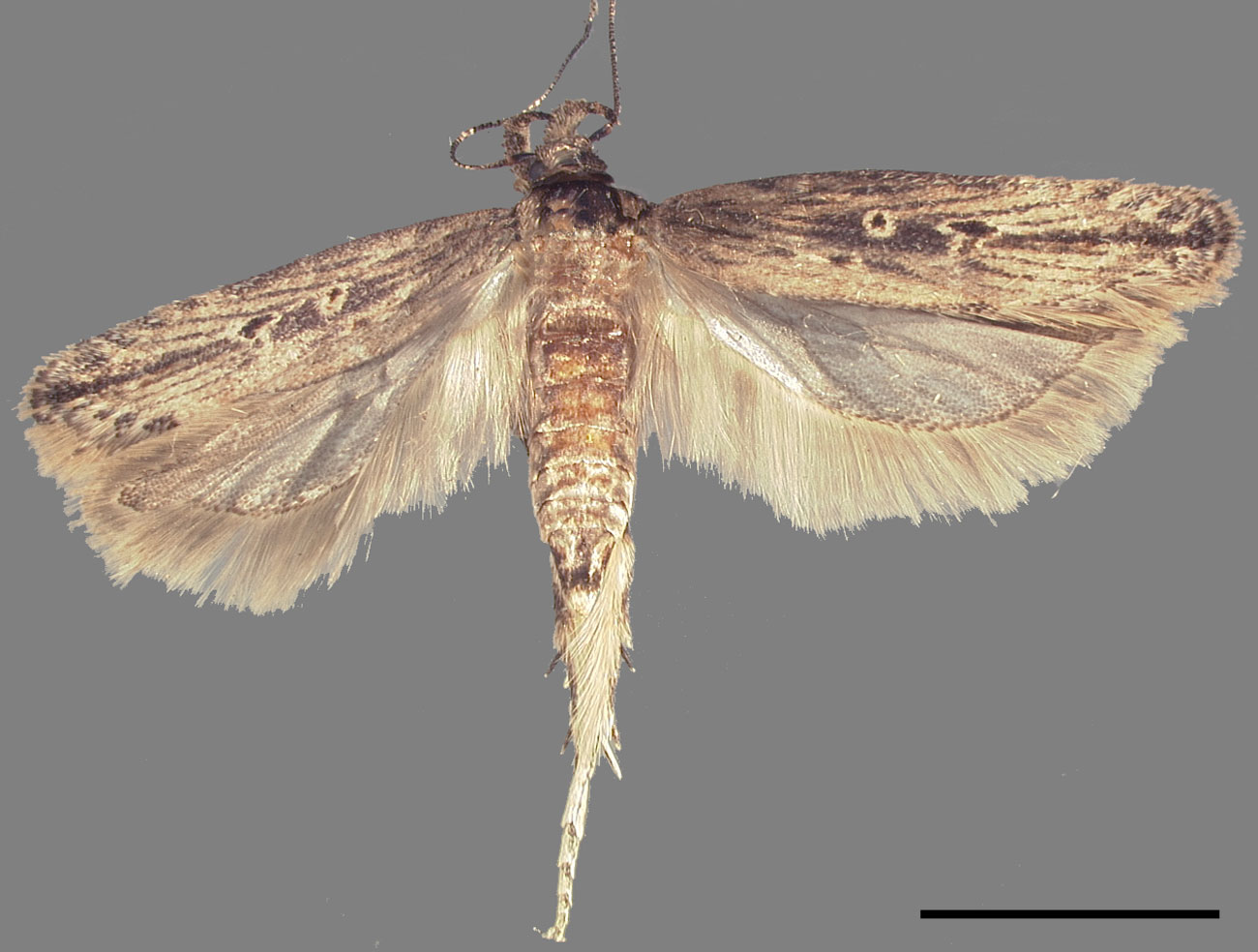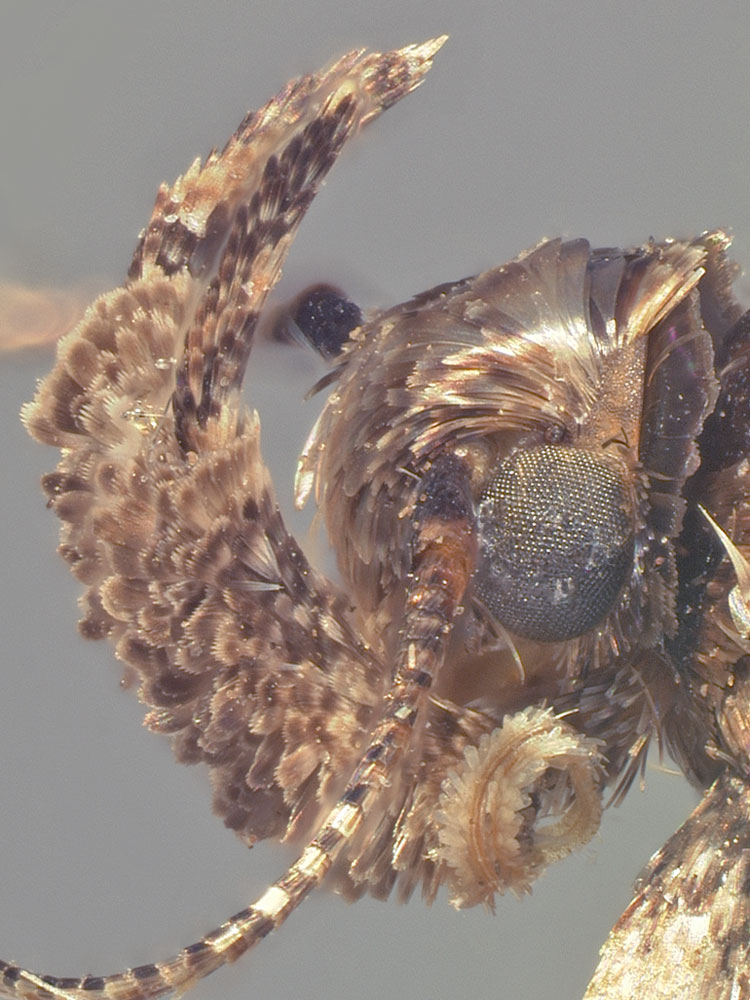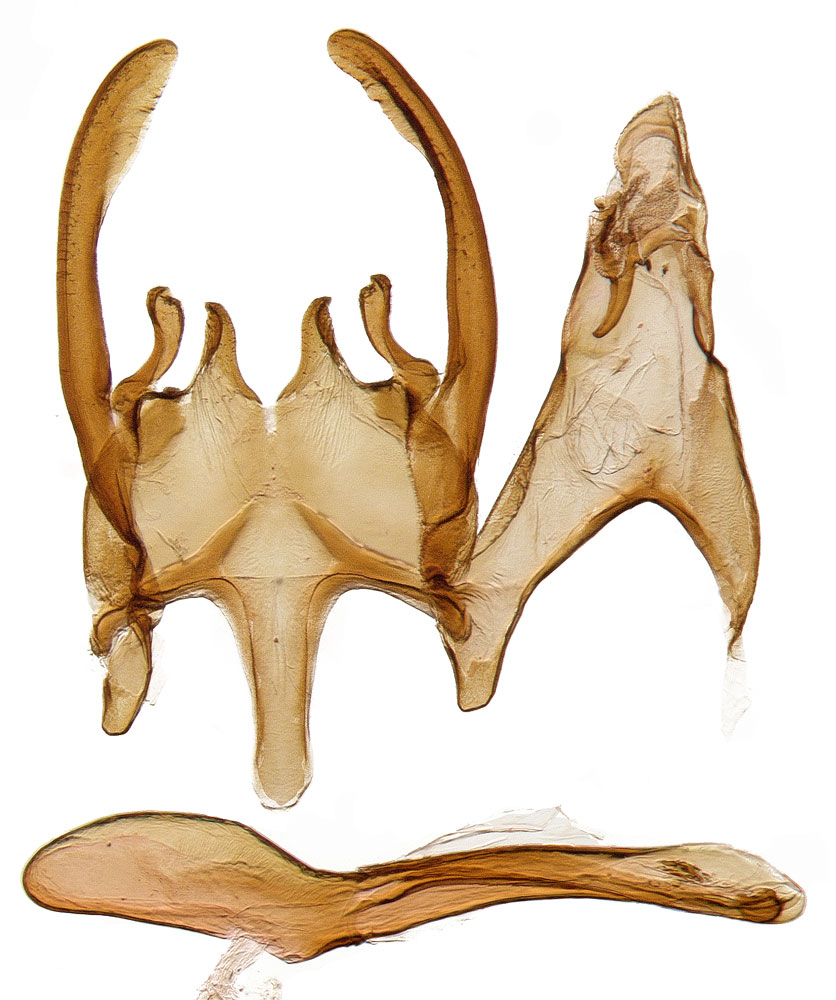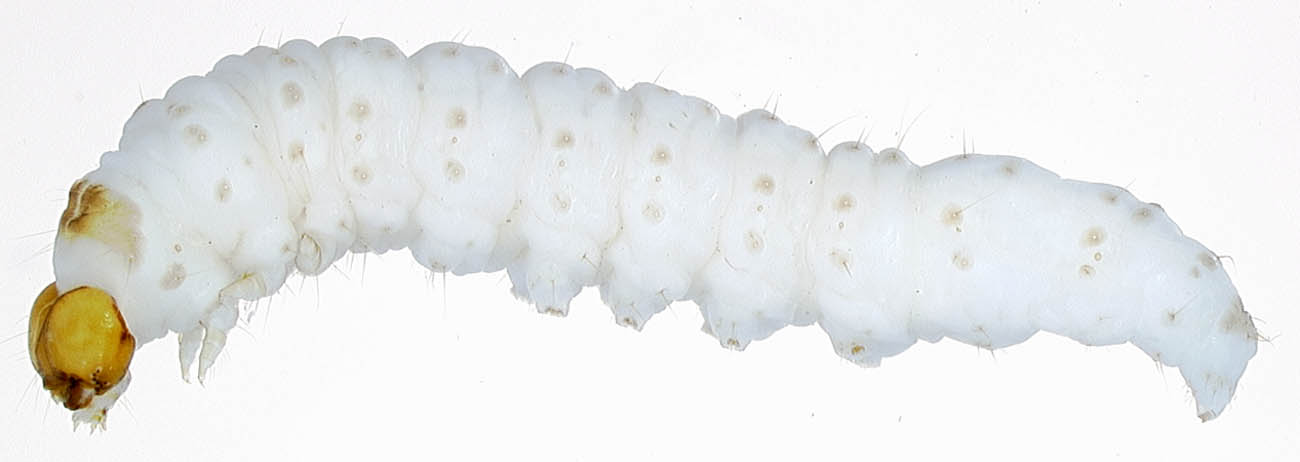Tecia solanivora
|
Tecia solanivora female habitus. Scale = 5 mm. |
|
Tecia solanivora head of female. |
|
Tecia solanivora male genitalia. |
|
Tecia solanivora female genitalia. |
|
Larva of Tecia solanivora. (Colombia; Hasbrouck Insect Collection). |
|
Head and prothoracic shield of Tecia solanivora. (Colombia; Hasbrouck Insect Collection). |
Name
Tecia solanivora (Povolný, 1973)
Common names: Guatemalan potato moth (English); teigne guatémaltèque de la pomme de terre (French); polilla guatemalteca de la papa, polilla gigante de la papa, polilla centroamericana, palomilla de la papa, polilla de Guatemala (Spanish).
Original combination: Scrobipalpopsis solanivora Povolný, 1973
Synonyms: none
Alternative combination: Ptycerata solanivora
Classification: Gelechioidea: Gelechiidae: Gelechiinae: Gnorimoschemini
Adult recognition
Adults are about 8.7–11.0 mm in forewing length. They are brown or brownish gray, with two grayish black spots in the discal cellDiscal cell:
An open area between the radial and cubital veins from which most other veins radiate.
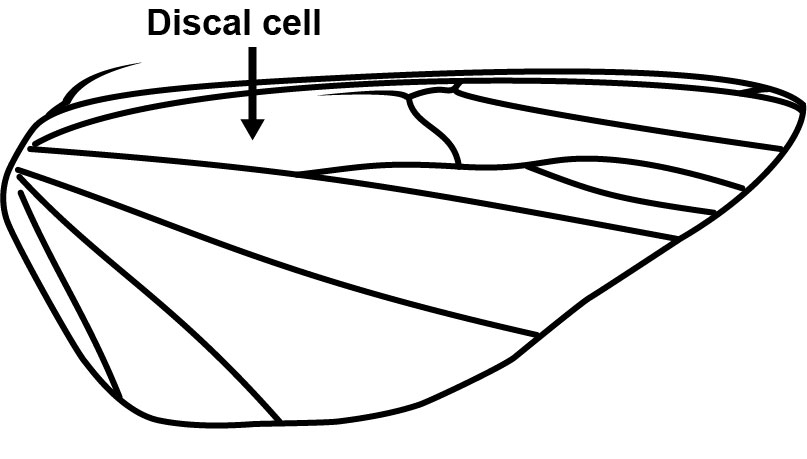 and a grayish black longitudinal streak from one fifth of median to preapex. The labial palpusLabial palpus:
and a grayish black longitudinal streak from one fifth of median to preapex. The labial palpusLabial palpus:
The more prominent, elongate pair of appendages on the head, usually three-segmented (pl. palpi).
-800px.jpg) is upturned. The hindwing is subrectangular. The sexes are dimorphic in size and coloration. Males (not illustrated) are smaller than females, dark brown or brownish-gray in color, and marked with a wing pattern of two stigmata but mostly without strong longitudinal lines. Females are marked with a wing pattern of three stigmata and longitudinal lines. Male genitalia have a hook-shaped gnathosGnathos:
is upturned. The hindwing is subrectangular. The sexes are dimorphic in size and coloration. Males (not illustrated) are smaller than females, dark brown or brownish-gray in color, and marked with a wing pattern of two stigmata but mostly without strong longitudinal lines. Females are marked with a wing pattern of three stigmata and longitudinal lines. Male genitalia have a hook-shaped gnathosGnathos:
A variously shaped bridge-like structure, usually hooked or bowed, crossing the tegumen below the uncus.
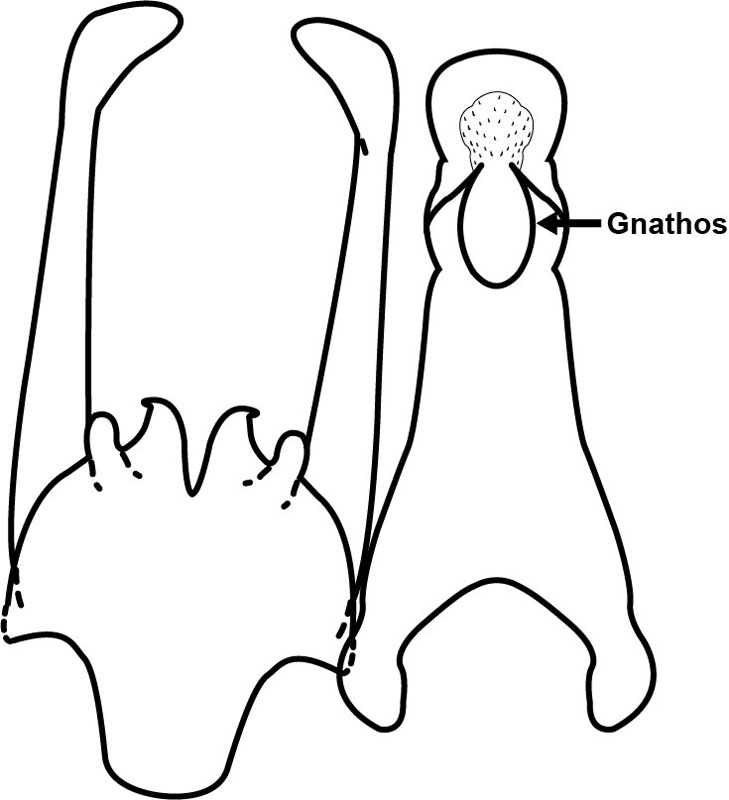 , and the valvaValva:
, and the valvaValva:
One of the pair of large lateral appendages of the male genitalia (pl. valvae).
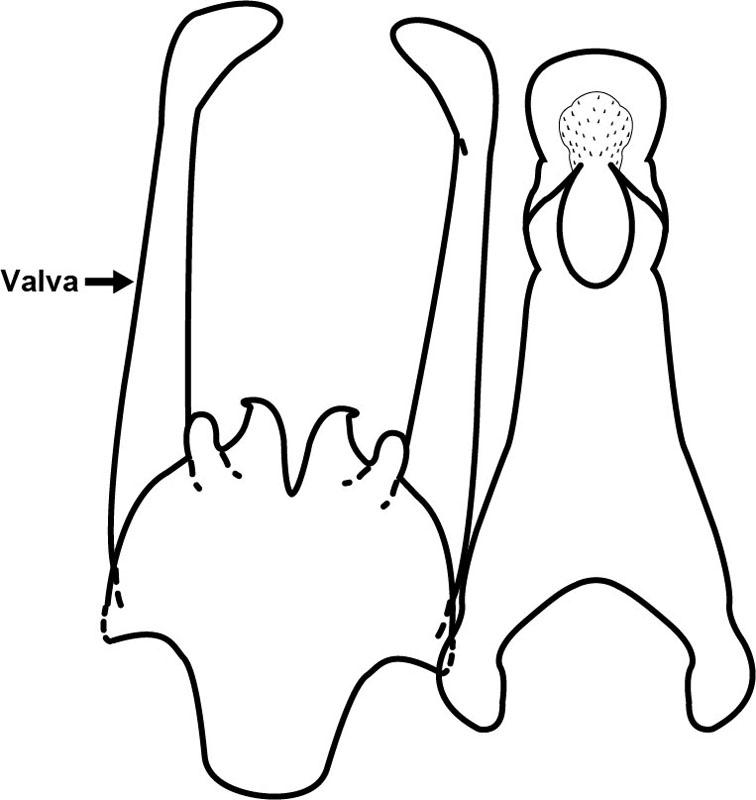 is elongate and regularly curved. The vinculumVinculum:
is elongate and regularly curved. The vinculumVinculum:
The ventral half of the male genitalia, from which the valvae arise.
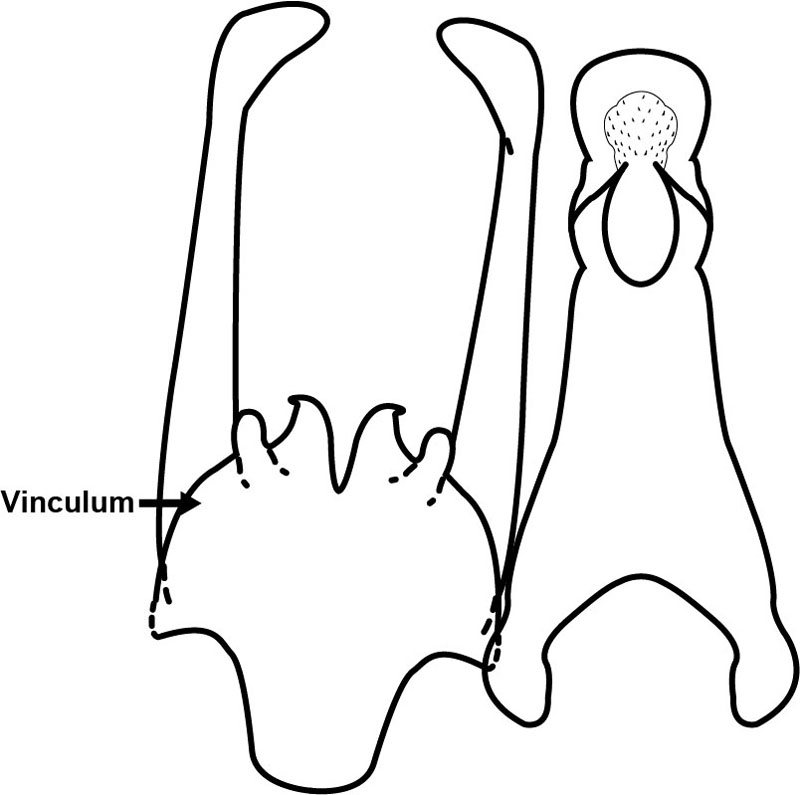 is deeply excavated medially and has paired conical processes with outwardly curved tips. Females have the antrumAntrum:
is deeply excavated medially and has paired conical processes with outwardly curved tips. Females have the antrumAntrum:
Posterior section of the ductus bursae, posterior of the colliculum.
 not developed and a thorn-like signumSignum:
not developed and a thorn-like signumSignum:
Any sclerite, sclerotized area, or discrete granular area on the wall of the corpus bursae (pl. signa).
 with base not protruding.
with base not protruding.
Immature stages
Larvae when fully grown are about 12–15 mm long. The prothoracic shieldProthoracic shield:
Also called the T1 shield. In the larva, the extensive sclerotized area of the dorsal half of the prothorax. It bears six setae on each side, and its color pattern is often diagnostic.
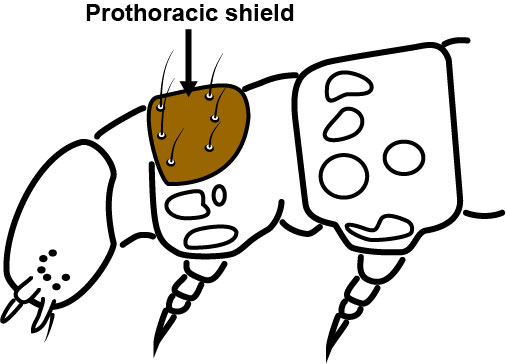 is uniformly brown or black. The line joining setae L1 and S2 is posterior to stemma I. The mandibleMandible:
is uniformly brown or black. The line joining setae L1 and S2 is posterior to stemma I. The mandibleMandible:
The chewing mouthparts of the larva, typically with teeth and two setae.
 is triangular with 3 or 4 teeth. The SD1 pinaculumPinaculum:
is triangular with 3 or 4 teeth. The SD1 pinaculumPinaculum:
In the larva, a raised, blister-like area that is often but not necessarily pigmented. They normally surround a seta, or if more than one seta, they are considered to be fused. Some taxa, especially internally boring larvae, may have extra pinacula without setae.
 of the abdomen is much larger than the corresponding spiracleSpiracle:
of the abdomen is much larger than the corresponding spiracleSpiracle:
Respiratory openings, mainly of interest for larval chaetotaxy. One pair on most segments.
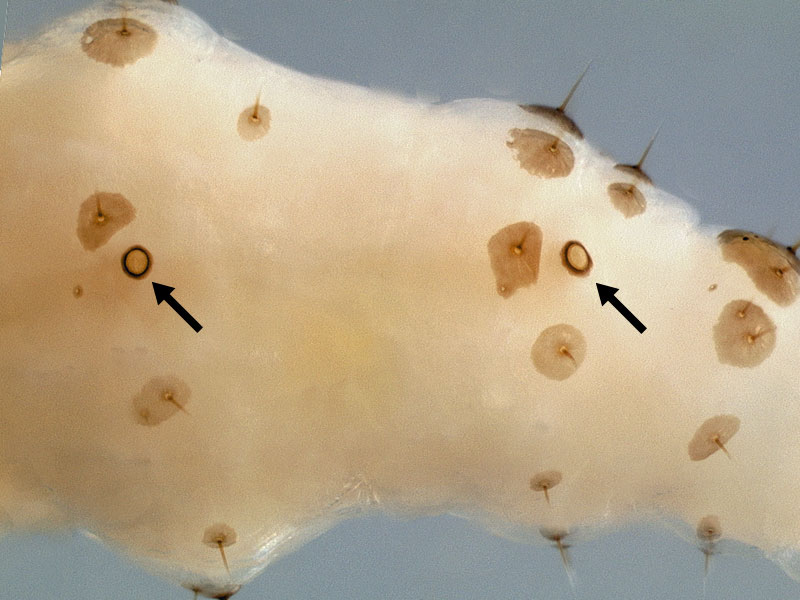 of that segment. The crochetsCrochets:
of that segment. The crochetsCrochets:
Tiny, hook-like, sclerotized setae on the abdominal and anal prolegs of larvae. 'Uni-,' 'bi-,' and 'triordinal' refer to the relative sizes of crochets (one, two, or three different sizes).
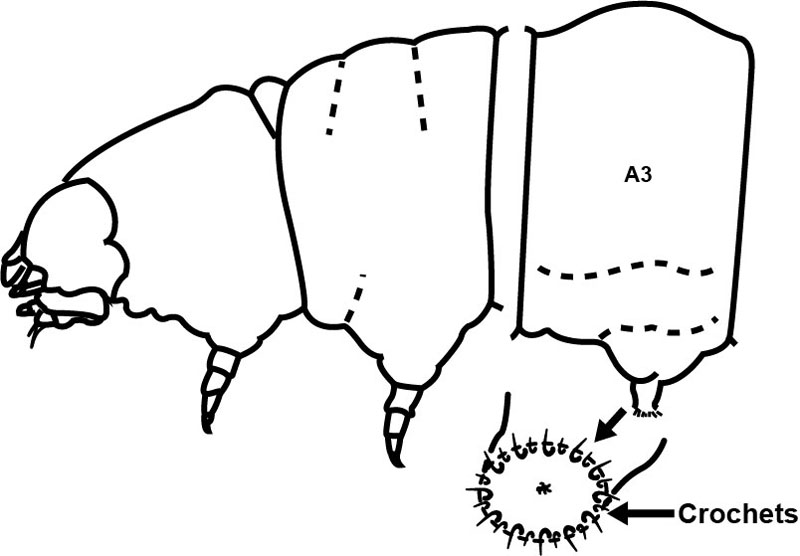 on A3-6 are mostly uniordinal, and the L group of A9 is usually bisetose (occasionally trisetose on one side only).
on A3-6 are mostly uniordinal, and the L group of A9 is usually bisetose (occasionally trisetose on one side only).
PDF - Dichotomous key to Gelechiid larvae
Similar species
This species is can be recognized by its large size and by the forewing pattern with two grayish-black spots in the discal cellDiscal cell:
An open area between the radial and cubital veins from which most other veins radiate.
 and a grayish-black longitudinal streak from the median fifth to the preapex.
and a grayish-black longitudinal streak from the median fifth to the preapex.
The well developed outer tooth, pigmented thoracic legs, bisetose L group and hairlike SD1 on A9 and the Latin American/European distribution will separate Tecia solanivora from other species in this Tool.
Behavior
Eggs are laid at dusk, singularly or in groups, in the soil near the base of the host-plant, on uncovered tubers, and occasionally on the foliage of host-plant. However, females can deposit eggs on tubers in storage facilities. After eclosing, larvae penetrate and attack the tubers to produce multiple galleries, and they can completely destroy the tubers.
Distribution
Native to South America. South America (Venezuela, Colombia, Ecuador, Peru), Central America and Caribbean (Guatemala, CostaCosta:
(1) The anterior margin of the wing.
(2) In the male genitalia, the dorsal margin of the valva.
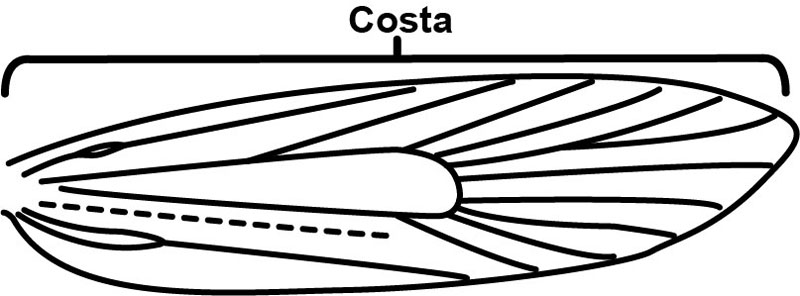 Rica, El Salvador, Honduras, Panama), Mexico, Europe (Spain).
Rica, El Salvador, Honduras, Panama), Mexico, Europe (Spain).
Hosts
Solanum tuberosum L. (Irish potato)
Comments
Since this species was first described from CostaCosta:
(1) The anterior margin of the wing.
(2) In the male genitalia, the dorsal margin of the valva.
 Rica in 1973, its range has been extended to be in Central America and further into South America. Recently, it was found in Mexico. Now it is reported to occur in Spain (Canary Islands). This species is known as a serious pest on potato crops and stocks in these countries. Also, damage caused by this species is known to possibly lead to secondary rotting.
Rica in 1973, its range has been extended to be in Central America and further into South America. Recently, it was found in Mexico. Now it is reported to occur in Spain (Canary Islands). This species is known as a serious pest on potato crops and stocks in these countries. Also, damage caused by this species is known to possibly lead to secondary rotting.
Literature
Busck 1939Busck 1939:
Busck A. 1939. Restriction of the genus Gelechia (Lepidoptera: Gelechiidae), with descriptions of new genera. Proceedings of the United States National Museum 86: 563-593, pl. 58-71.
EPPO 2005aEPPO 2005a:
EPPO. 2005a. Tecia solanivora : Data sheets on quarantine pests. EPPO Bulletin (European and Mediterranean Plant Protection Organization) 35: 399-401.
Hilje 1994Hilje 1994:
Hilje L. 1994. Caracterizacioacute;n del dantilde;o de las polillas de la papa, Tecia solanivora y Phthorimaea operculella (Lepidoptera: Gelechiidae), en Cartago, Costa Rica. Manejo Integrado de Plagas 31: 43-46.
Hill 1975Hill 1975:
Hill D. 1975. Agricultural Insect Pests of the Tropics and Their Control. Cambridge University Press, New York.
Hill 1987Hill 1987:
Hill D. 1987. Agricultural Insect Pests of Temperate Regions and Their Control. Cambridge University Press, New York.
Lal and Krishna Prasad 1987Lal and Krishna Prasad 1987:
Lal L and Krishna Prasad KS. 1987. Bionomics and management strategies of potato tuberworm. Pesticides 23: 53-57.
Misra and Agrawal 1988Misra and Agrawal 1988:
Misra SS and Agrawal HO. 1988. Potato pests in India and their control. Tropical Pest Management 34: 199-209.
Povolný 1975Povolný 1975:
Povolný D. 1975. On three neotropical species of Gnorimoschemini (Lepidoptera, Gelechiidae) mining Solanaceae. Acta Universitatis Agriculturae 23: 379–393.
Povolný 1994Povolný 1994:
Povolný D. 1994. Gnorimoschemini of southern South America VI: Identification keys, checklist of Neotropical taxa and general considerations (Insecta, Lepidoptera, Gelechiidae). Steenstrupia (Copenhagen) 20: 1–42.
Povolný 2004Povolný 2004:
Povolný D. 2004. The Guatemalan potato tuber moth (Scrobipalpopsis solanivora Povolný, 1973) before the gateways of Europe (Lepidoptera, Gelechiidae). Acta Universitatis Agriculturae, Brno 52: 183–196.
Povolný and Hula 2004Povolný and Hula 2004:
Povolný D and Hula V. 2004. Ein neuer, nach Südwesteuropa eindringender Kartoffelschädling, die Goße Kartoffel-Knollenmotte, Scrobipalpopsis solanivora (Lepidoptera: Gelechiidae). Entomologia Generalis 27: 155–168.
Roblero et al. 2011Roblero et al. 2011:
Roblero ENC, Vera AC, and Malo EA. 2011. First report of Tecia solanivora (Lepidoptera: Gelechidae) attacking the potato Solanum tuberosum in Mexico. Florida Entomologist 94: 1055-1056.
Torres et al. 1997Torres et al. 1997:
Torres WF, Notz A, and Valencia L. 1997. [Life cycle and other aspects of the biology of Tecia solanivora in Tachira state, Venezuela.] Boletiacute;n de Entomologia Venezolana 12: 95-106.

